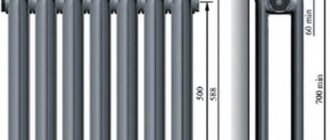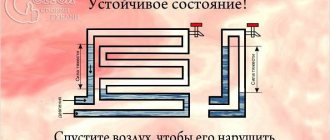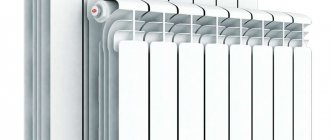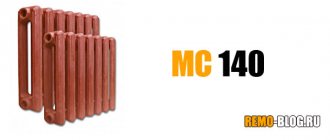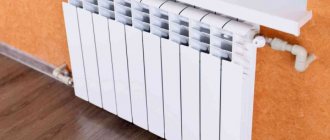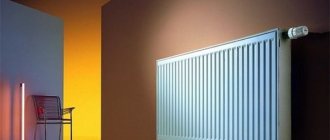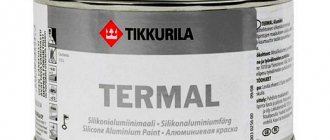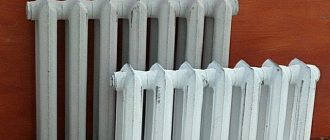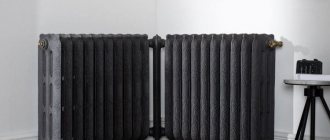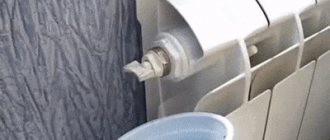As the market fills with new building materials and components, the need for high-quality and beautiful equipment increases.
In connection with this and the demands of the time, many people are embarking on major renovations of their homes and industrial premises. All old water supply and sewerage, heating, and electricity systems are being replaced. They replace window and door structures, flooring, and roofs of private houses. However, when replacing old equipment, old cast iron batteries are often left behind and pre-washed. What is the popularity of these designs, known to us since Soviet times? Why do many builders do not advise replacing old cast iron batteries? Of course, the design of old cast iron structures cannot be compared with new types of heating devices. That’s why new metal-plastic distribution pipes and old batteries of 5-8 sections sometimes seem like a strange combination against the backdrop of expensive wallpaper. Despite the fact that they were carefully painted with light paint, old-fashioned radiators do not want to blend smoothly into the interior design. But from the point of view of practicality and durability, they are a valuable material.
Assortment of heating radiators
Modern manufacturers of heating radiators offer a wide range of such designs. Basically, heating radiators differ in the material of manufacture and appearance with a certain color design. The difference is also expressed in size and technical characteristics. Along with new models of heating radiators made of steel, aluminum, bimetallic, copper, plastic materials and various alloys, many people welcome cast iron heating radiators, and which is better is up to consumers to judge. Modern models have an excellent design, made of various materials, have a beautiful appearance, practical shapes, and light weight. But in other respects they are inferior to the cast iron structures we are used to, which are classified as Soviet-era.
Thermal inertia and efficiency - cast iron radiators or steel?
A very important criterion for those who want to make the most of their heating capabilities is the thermal inertia of radiators. This property of the metal has two sides: when operating a system with room temperature control, it is necessary that the radiators heat up quickly and reduce the temperature just as quickly. If you expect to “drive” the system, for example, at the dacha, once so that it retains heat for some time, then high inertia is needed.
Cast iron has high thermal inertia; it heats up and cools down longer than steel. This can significantly affect the efficiency of heating, which is used constantly for a long time. For rational consumption of thermal energy, that is, to save gas or electricity, it is more reasonable to install tubular steel radiators of the Harmony type from KZTO.
Main technical characteristics of cast iron radiators
The batteries are made of a strong and homogeneous cast iron alloy. Each section is cast individually and then joined into a specific group. To install heating batteries, you need to decide how many sections are needed. Their number can range from 3 to 5-6, and sometimes up to 12, and depends on many factors , among which are:
- room area;
- number of windows;
- presence of double-glazed windows;
- room height;
- floor;
- corner placement of an apartment in a multi-storey building;
- other factors influencing the level of energy efficiency.
The technical characteristics of cast iron radiators are related to their endurance and reliability. The maximum coolant temperature is 130-150 degrees. The maximum working pressure is considered to be 9-12 bar. One section of standard batteries made of MS 140 cast iron holds just over a liter of water (1.11-1.45). One section weighs within 6 kg (5.7 – 7.1), and the section width is 98 mm. The technical characteristics of cast iron radiators are designed for installation with a distance between the wall and the radiator of 2-5 cm and an installation height above the floor plane of 10 cm.
Generally accepted advice:
If there are several windows in the room, then heating radiators should be installed under each window. In corner apartments, the outside walls should be insulated using modern methods or the number of sections in the battery should be increased.
The calculation of the number of batteries is determined by multiplying the area of the room by 100 W and dividing by the heat transfer that is obtained from the operation of one section.
The heat output from the 1st section of MS 140 is considered to be 175 W. From this calculation it is assumed that for a room of 18 sq.m it is necessary: 18x100:175=10.2
For better efficiency, the resulting indicator is increased upward. Therefore, for a room of 18 square meters, a cast iron radiator MS 140 with 11 sections is suitable.
The best wall-mounted models
Wall installation of a cast iron radiator is the most common and easiest way. Among the advantages of such structures it is worth noting:
- high heat transfer rate due to the large area of contact with air;
- variety of sizes, shapes, designs - you can choose according to the interior of the room;
- high heating speed;
- ease of installation;
- saving space under the window.
Keep in mind! As for the disadvantages, these include:
- uneven heating of the room - warm air accumulates in the ceiling area, the floor still remains cold;
- it is impossible to unnoticedly route pipes to the radiator;
- heavy weight, not suitable for plasterboard walls.
TOP 5 best models with wall installation in terms of price and quality ratio.
Konner Modern 500
The perfect combination of style and high quality heating .
The outer surface is perfectly processed - has no unnecessary bulges. Therefore, it fits easily under the window sill to the wall.
It is compact and can be hidden well under a curtain, although it can become a harmonious element of a room interior.
In appearance, this model is similar to the standard aluminum one, but is superior in quality.
Specifications:
- connection - lateral;
- type - sectional;
- maximum operating pressure - 12 bar;
- height - 60 cm;
- width of one section - 6.4 cm;
- thickness - 9.6 cm;
- the weight of one section is 4.9 kg.
Advantages
- beautiful exterior;
- rich equipment;
- good heat dissipation;
- versatility;
- endurance;
- reliability.
Flaws
- the coating is easily scratched;
- not very high quality painting, sagging is visible;
- high price.
STI Nova 500 x10
Sectional radiator with a laconic design and high quality workmanship.
The device is made of cast iron, but in appearance it does not differ from modern radiators.
Able to withstand high coolant temperatures, as well as increased short-term pressure.
With its help, you can fully heat a room up to 20 square meters in size.
Specifications:
- connection - lateral;
- type - sectional;
- maximum operating pressure - 12 bar;
- height - 58 cm;
- width of one section - 6 cm;
- thickness - 8.5 cm;
- weight - 42 kg.
Advantages
- low weight as for a cast iron product;
- modern design;
- quickly warms up the room;
- high-quality coating;
- low price.
Flaws
- not the most convenient standard width, it is better to buy in separate sections;
- difficult to install in rooms with plasterboard walls;
- the paint chips easily - must be protected from mechanical damage.
RETROstyle TOULON 900/70
This cast iron radiator is made in a retro style, so it will ideally complement the interior of the corresponding theme.
Despite the fact that the dimensions of the radiator cannot be called compact, it will harmoniously fit into a room designed in a loft or retro style.
Withstands pressure up to 15 atmospheres, which is quite suitable for an apartment and will ensure a long service life.
Specifications:
- connection - lateral;
- type - sectional;
- maximum operating pressure - 10 bar;
- height - 98 cm;
- width of one section - 6 cm;
- thickness - 7 cm;
- the weight of one section is 6.1 kg.
Advantages
- original appearance;
- low price;
- long service life;
- ease of maintenance;
- reliability.
Flaws
- the build quality is not always high - the joints are visible;
- the surface is subject to mechanical damage;
- heavy weight;
- The radiator on the back side is poorly painted.
Ogint Fortis 300
A universal device with a modern exterior that can be used in rooms for any purpose.
The design consists of 10 elements, which is very convenient - no need to calculate the required size.
All radiators of this model come with the same dimensions.
The compact size allows you to fully heat medium and small rooms.
Specifications:
- connection - lateral;
- type - sectional;
- maximum operating pressure - 12 bar;
- height - 38 cm;
- width - 58 cm;
- thickness - 8 cm;
- weight - 28 kg.
Advantages
- compact size;
- a light weight;
- low cost;
- modern design;
- versatility;
- availability of protection against water hammer.
Flaws
- not sold in separate sections;
- poor equipment;
- The surface gets scratched quickly.
Ogint Fortis 500
Cast iron radiator with a modern appearance and high quality.
This model is similar to Ogint Fortis 300, only it has a greater height.
Therefore, this design is suitable for heating rooms with dimensions of more than 20 square meters.
It will successfully fit into the interior of any style - both classic and modern.
Specifications:
- connection - lateral;
- type - sectional;
- maximum operating pressure - 12 bar;
- height - 58 cm;
- width of one section - 5.8 cm;
- thickness - 8 cm;
- the weight of one section is 4 kg.
Advantages
- reliability;
- water hammer protection;
- a light weight;
- low cost;
- modern design;
- versatility.
Flaws
- poor equipment;
- the surface is easily subject to mechanical damage;
- bulky design.
Advantages of cast iron structures
Nowadays, various types of heating radiators are used, among which there are modern cast iron products. The current cast iron and its alloys are no different from the previous ones. The only thing stopping us is the “exorbitant” price of modern cast iron structures. In this case, you can use old cast iron batteries after carrying out a preliminary inspection, washing and cleaning them. Cast iron heating radiators, and which is better: used or modern designs made of different materials, are decided on an individual basis. A long stay at the peak of glory of cast iron batteries is due to a number of undeniable advantages:
- chemical resistance. Centrally supplied water may have a reddish-brown color and contain chemical additives. Various chemical compounds negatively affect the condition of modern plastic radiators without damaging cast iron;
- duration of operation. Our apartments still have heating radiators that were installed in the middle of the last century. The technical characteristics of cast iron radiators give them a service life of 50 years, although in practice their service life is 100 years or more.
- inertia. Heated cast iron radiators retain heat for a long period of time. Heat transfer when the system is turned off decreases gradually;
- low level of hydraulic resistance. Thanks to the large internal diameter and sufficient volume of cast iron sections, there is no interference with water circulation. The operation of the system is slightly affected by salt deposits and the presence of rust. Only when the batteries are completely “clogged” with various accumulations does hot water not flow into one or more sections of the cast iron batteries. Therefore, to the question: “Which is better: cast iron heating radiators or plastic ones?” there is a clear answer: “Of course, cast iron!”;
- strength. Cast iron batteries can withstand pressure of 18 atmospheres.
Bimetallic or cast iron radiators?
The question of which heating radiators are better, cast iron or bimetallic, is not easy to answer. After all, bimetallic devices have a heat transfer rate that is twice as good. At the same time, cast iron radiators are much more reliable.
When considering heating radiators, cast iron heating radiators MS 140 are cheap. Especially when compared with bimetallic ones. True, many models of cast iron radiators do not have a special design. And often they try to hide them behind bars, in niches or behind screens. And the cost of finishing work is quite decent. Of course, you can buy cast iron heating radiators second-hand, they are cheaper, and thereby save a little. But no one guarantees the high quality of previously used batteries. In addition, cast iron needs to be painted from time to time. In view of these disadvantages of cast iron batteries, some prefer bimetal.
It is worth noting that not all modern cast iron batteries have an unsightly appearance. Decorative and designer models are available for sale. True, prices for cast iron heating batteries will be much higher. Even in comparison with bimetal. There are also models that look similar to their bimetallic and aluminum counterparts. They are not cheap. The weight remains high, and the heat transfer is low.
Cast iron radiators are the optimal solution if:
- pressure drops no more than 12 bar;
- low hydraulic resistance of the system is required;
- the system uses an aggressive coolant;
- large thermal inertia is required;
- coolant temperature is above 100 degrees.
If you don’t know whether to buy cast iron or bimetallic radiators, then you should pay attention to the following key parameters:
- coolant contamination level. If there is a lot of dirt, the internal tubes of the bimetallic battery may become clogged. To avoid this, it is necessary to additionally install mud traps and filters;
- hydrogen coefficient of the coolant. Bimetal works normally in systems with a pH of 7-8;
- possible peak pressure values. The rupture pressure of bimetal is on average 80-90 atm.
For heating radiators, the price of cast iron or bimetallic depends on the manufacturer, quality and model.
There is no clear answer about which radiators are better.
Everything depends on the parameters of the heating system and conditions of use. For example, cast iron is ideal for systems with natural circulation. But for multi-storey buildings, preference should be given to bimetallic batteries. For individual heating systems with forced circulation, aluminum radiators are the best choice. The cost of radiators made from different materials varies. If your budget is limited, you can choose used options. For example, prices for cast iron heating batteries are quite low.
Disadvantages of cast iron structures for heating
Reading flattering reviews about the advantages of heating batteries made of cast iron or its alloys, a certain phase involuntarily arises that irreplaceable items do not exist. If cast iron heating structures were so perfect, then plastic, bimetallic, copper, and alloy heating radiators would not have appeared. The disadvantages of the design and technical characteristics of cast iron radiators include:
- impressive size and heavy weight;
- unpresentable appearance;
- presence of hard-to-reach places for painting and care;
- inability to regulate temperature;
- slow heating of a cold room.
However, such shortcomings are not so significant and are often acceptable.
Pros and cons of cast iron batteries
The advantages of the new type of cast iron batteries undoubtedly include the fact that they are 30% convection , and 70% of the heat is obtained through radiation, which makes it possible to warm the room evenly. There are also disadvantages, the biggest of which is that batteries hold a large amount of water, high inertia does not make it possible to quickly regulate the temperature, thereby creating a problem in using batteries in controlled systems to maintain set parameters for a comfortable temperature. Most of these batteries operate at pressures up to 15 atm.
The heat emitted by cast iron batteries is of no small importance; it is much more useful than the spectrum emitted by other radiators.
Therefore, the use of cast iron still continues in room heating, and manufacturers are trying to offer new battery designs , improving old models.
Today there are models of cast iron radiators with a flat front panel, the sections are reduced in volume, and even greater inertia does not prevent the use of such radiators in a controlled heating system. Cast iron radiators are not affected by the quality of circulating water . They can be installed anywhere where water is drained for prophylaxis for 2 weeks, and stable, even heating is required. The main advantage of black and white is its durability. They have high wear resistance, original design, low price and a service life of about 50 years.
Advantages of cast iron batteries:
- fifty-year service life;
- have a large heat capacity provided by thick cast iron walls and a large amount of water;
- uniform heating of the room;
- center distance 500 mm (most popular);
- no high requirements for impurities contained in the coolant;
- corrosion processes ;
- high resistance to mechanical damage
Disadvantages of cast iron batteries:
- frequent manufacturing defects and unattractive appearance of older models;
- inconvenient battery installation;
- large weight and size;
- low operating pressure (6−9 atm);
- intolerance to sudden changes in pressure (water hammer) in the thermal system;
- difficulties in cleaning dirt and dust between sections;
- rough surface (modern models have no such drawback);
- the presence of cracks on the surface, leading to leaks and shortened service life;
- the likelihood of depressurization of joints;
- high inertia , which does not allow their use in a thermal automation system.
Manufacturers of cast iron batteries continue to improve their products. And now batteries are produced with improved technical parameters.
Cast iron heating radiators, and which ones are better
Of course, modern radiators have a peculiar beauty and practicality. Only their use is not adapted to our heat supply systems. Therefore, until centralized heating systems are improved, it is better not to install new radiators made of plastic materials. Cast iron heating radiators, and it’s up to you to decide which is better - new or old model. If the equipment is changed in your home, where water without chemicals is poured in and its temperature is maintained at a certain temperature, then the original versions (not Chinese) will last no less than indicated in the instructions for use.
Features of installation of cast iron radiators
Installation of cast iron radiators
Before installation, you need to stock up on all the necessary components and elements, you will need:
- adapters;
- couplings;
- corners;
- shut-off valves.
If the installation is carried out on your own, then as a shut-off valve it is more advisable to choose not an “American” ball valve of a complex design, but a regular radiator valve. The fact is that for a high-quality installation of an American one, you will need a special tool and work skills.
European cast iron radiators
In addition, during installation you will need drives that have a thread diameter corresponding to the battery. Before connecting the battery to the pipes, you need to make sure that they are located at a slight inclination towards the water flow.
During installation, it is important to maintain the size of the gaps between the battery, floor and wall. Due to the large weight of these heating devices, installing them alone is extremely difficult.
